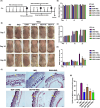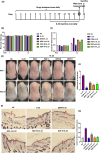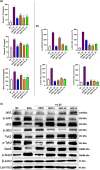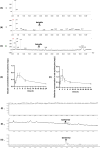Improvement effects of a novel Chinese herbal formula in imiquimod and IL-23-stimulated mouse models of psoriasis
- PMID: 38858762
- PMCID: PMC11165727
- DOI: 10.1186/s13020-024-00951-9
Improvement effects of a novel Chinese herbal formula in imiquimod and IL-23-stimulated mouse models of psoriasis
Abstract
Background: Psoriasis is a long-term inflammatory skin disease. A novel herbal formula containing nine Chinese herbal medicines, named Inflammation Skin Disease Formula (ISDF), has been prescribed in clinics for decades.
Aims: To investigate the efficacy and action mechanisms of ISDF on psoriasis using imiquimod (IMQ) and Interleukin-23 (IL-23)-induced models in mice and reveal the pharmacokinetics profile of ISDF in rats.
Methods: Topical administration of IMQ and intradermal injection with IL-23 respectively induced skin lesions like psoriasis on the dorsal area of Balb/c and C57 mice. The mice's body weight, skin thickness, and psoriasis area and severity index (PASI) were assessed weekly. SD rats were used in the pharmacokinetics study and the contents of berberine and baicalin were determined.
Results: The PASI scores and epidermal thickness of mice were markedly decreased after ISDF treatment in both models. ISDF treatment significantly decreased the contents of IL-17A and IL-22 in the serum of IMQ- and IL-23-treated mice. Importantly, ISDF markedly downregulated IL-4, IL-6, IL-1β, and tumor necrosis factor α (TNF-α) gene expression, and the phosphorylation of NF-κB p65, JNK, ERKs and MAPK p38 in IMQ-treated mice. The protein phosphorylation of Jak1, Jak2, Tyk2 and Stat3 was significantly mitigated in the ISDF-treated groups. The absorption of baicalin and berberine of ISDF through the gastrointestinal tract of rats was limited, and their distribution and metabolism in rats were also very slow, which suggested ISDF could be used in the long-term application.
Conclusions: ISDF has a strong anti-psoriatic therapeutic effect on mouse models induced with psoriasis through IMQ and IL-23, which is achieved by inhibiting the activation of the Jak/Stat3-activated IL-23/Th17 axis and the downstream NF-κB signalling and MAPK signalling pathways. ISDF holds great potential to be a therapy for psoriasis and should be further developed for this purpose.
Keywords: IL-23/Th17 axis; Imiquimod; Inflammation skin disease formula; Jak/Stat pathway; MAPK pathway; Psoriasis.
© 2024. The Author(s).
Conflict of interest statement
The authors declare no conflicts of interest.
Figures






Similar articles
-
Dang-Gui-Liu-Huang Tang a traditional herbal formula, ameliorates imiquimod-induced psoriasis-like skin inflammation in mice by inhibiting IL-22 production.Phytomedicine. 2018 Aug 1;47:48-57. doi: 10.1016/j.phymed.2018.04.051. Epub 2018 May 9. Phytomedicine. 2018. PMID: 30166108
-
Topical anti-TNF-a ssDNA aptamer decreased the imiquimod induced psoriatic inflammation in BALB/c mice.Cytokine. 2023 Dec;172:156406. doi: 10.1016/j.cyto.2023.156406. Epub 2023 Oct 23. Cytokine. 2023. PMID: 37879125
-
Cimifugin ameliorates imiquimod-induced psoriasis by inhibiting oxidative stress and inflammation via NF-κB/MAPK pathway.Biosci Rep. 2020 Jun 26;40(6):BSR20200471. doi: 10.1042/BSR20200471. Biosci Rep. 2020. PMID: 32515468 Free PMC article.
-
Eupatilin inhibits keratinocyte proliferation and ameliorates imiquimod-induced psoriasis-like skin lesions in mice via the p38 MAPK/NF-κB signaling pathway.Immunopharmacol Immunotoxicol. 2023 Apr;45(2):133-139. doi: 10.1080/08923973.2022.2121928. Epub 2022 Oct 28. Immunopharmacol Immunotoxicol. 2023. PMID: 36305632
-
Primidone: a clinically promising candidate for the treatment of psoriasis.Cell Death Discov. 2025 Jun 10;11(1):275. doi: 10.1038/s41420-025-02552-3. Cell Death Discov. 2025. PMID: 40494888 Free PMC article. Review.
References
-
- Mehrmal S, Uppal P, Nedley N, Giesey RL, Delost GR. The global, regional, and national burden of psoriasis in 195 countries and territories, 1990 to 2017: a systematic analysis from the global burden of disease study 2017. J Am Acad Dermatol. 2021;84(1):46–52. doi: 10.1016/j.jaad.2020.04.139. - DOI - PubMed
Grants and funding
LinkOut - more resources
Full Text Sources
Research Materials
Miscellaneous

